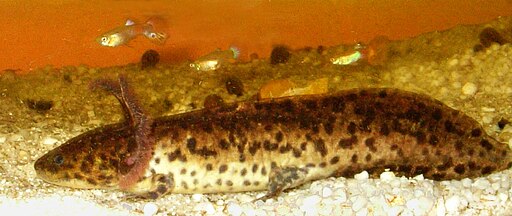Superregnum: Eukaryota
Regnum: Animalia
Subregnum: Eumetazoa
Cladus: Bilateria
Cladus: Nephrozoa
Superphylum: Deuterostomia
Phylum: Chordata
Cladus: Craniata
Subphylum: Vertebrata
Infraphylum: Gnathostomata
Superclassis: Tetrapoda
Classis: Amphibia
Subclassis: Lissamphibia
Ordo: Urodela
Subordo: Salamandroidea
Familia: Ambystomatidae
Genus: Ambystoma
Species: Ambystoma andersoni
Name
Ambystoma andersoni Krebs & Brandon, 1984
Type locality: "Laguna de Zacapu, 2000 m elevation, Michoacan, Mexico".
Holotype: AMNH 100096.
References
Krebs and Brandon, 1984, Herpetologica, 40: 238.
Frost, D. 2008. Amphibian Species of the World: an Online Reference. Version 5.2 (15 July, 2008). Electronic Database accessible at www.research.amnh.org/herpetology/amphibia. American Museum of Natural History, New York, USA. Ambystoma andersoni
AmphibiaWeb: Information on amphibian biology and conservation. [web application]. 2010. Berkeley, California: Ambystoma andersoni. AmphibiaWeb, available at http://amphibiaweb.org/.
2007 IUCN Red List of Threatened Species IUCN: Ambystoma andersoni (Critically Endangered) Downloaded on 26 July 2008.
Vernacular names
English: Anderson's Salamander
Anderson's salamander (Ambystoma andersoni) is a neotenic salamander from Zacapu Lagoon in the Mexican state of Michoacán.
This salamander is a relatively recent discovery, first described by Branden and Krebs in 1984. Ambystoma andersoni is named after James Anderson, a herpetologist with the American Museum of Natural History, who did extensive fieldwork studying Ambystoma and other amphibians and reptiles in Mexico.
Like all neotenic Ambystoma species, A. andersoni retains its larval features into adulthood. The mature salamander has medium-sized external gills with bright red filaments, and a prominent caudal fin. It has a large head and small limbs, as do the larvae. Its coloration is a strange pattern of black blotches on a red-brown base. The salamanders are totally aquatic and spend their whole lives in the same body of water.
Habitat
Lake Zacapu is small lake near Zacapu, sitting at an altitude of 2000 meters. The lake is located within the Mesa Central portion of Mexico, an area home to many neotenic Ambystoma species. It is temperate, with low salinity, and has a single stream originating from it.
Ambystoma andersoni is listed as critically endangered on the IUCN Red List.
References
IUCN SSC Amphibian Specialist Group (2015). "Ambystoma andersoni". IUCN Red List of Threatened Species. 2015: e.T59051A176772780. doi:10.2305/IUCN.UK.2015-4.RLTS.T59051A176772780.en. Retrieved 11 November 2021.
Wikispecies has information related to Ambystoma andersoni.
IUCN SSC Amphibian Specialist Group (2015). "Ambystoma andersoni". IUCN Red List of Threatened Species. 2015: e.T59051A176772780. doi:10.2305/IUCN.UK.2015-4.RLTS.T59051A176772780.en. Retrieved 11 November 2021. Database entry includes a range map and justification for why this species is critically endangered
Retrieved from "http://en.wikipedia.org/"
All text is available under the terms of the GNU Free Documentation License


